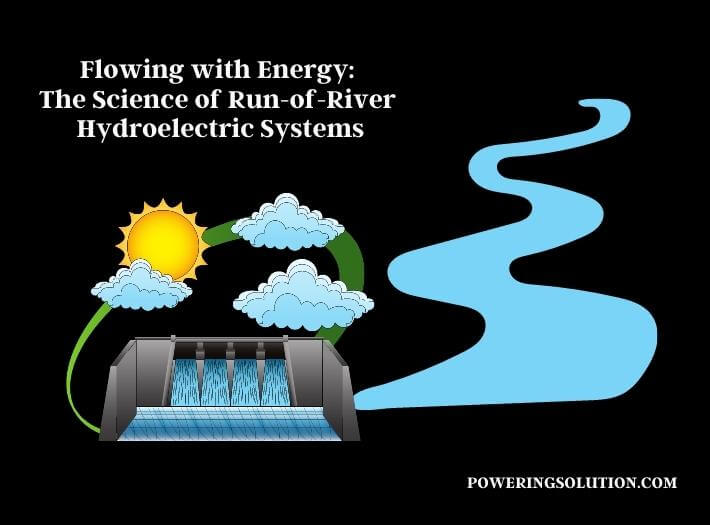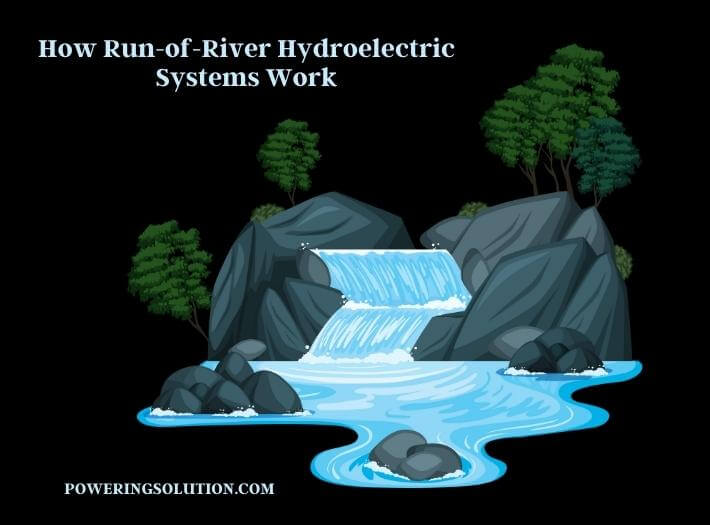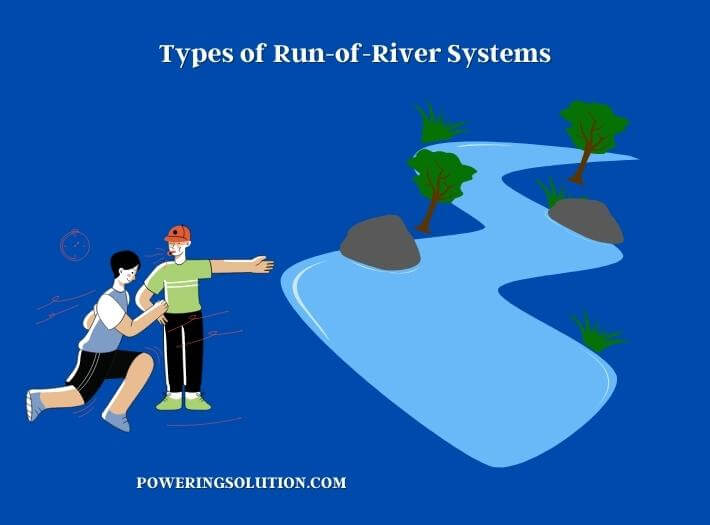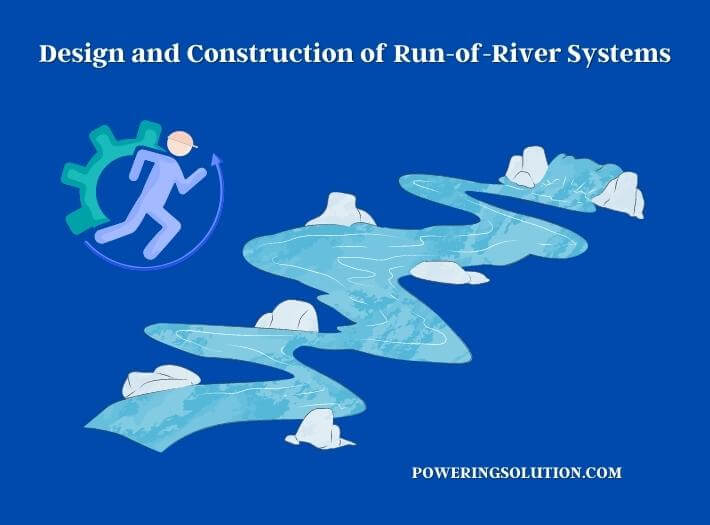Run-of-river hydroelectric systems are a type of hydroelectric power generation technology that harnesses the kinetic energy of flowing water to generate electricity. Unlike traditional hydroelectric dams, run-of-river systems do not require large-scale impoundment of water, which can cause significant environmental impacts such as flooding, habitat destruction, and displacement of communities.

Instead, run-of-river systems use a series of turbines to capture the energy of the natural flow of rivers and streams, generating clean and renewable energy with minimal impact on the surrounding environment.
How Run-of-River Hydroelectric Systems Work?
Run-of-river hydroelectric systems generate electricity by using the natural flow of a river or stream to turn a turbine and generate electricity. These systems differ from conventional hydroelectric power plants, which use a dam to create a reservoir and control the flow of water.
In a run-of-river system, a portion of the river or stream is diverted into a canal or pipeline, where it is channeled toward a turbine. The turbine is connected to a generator, which converts the mechanical energy of the flowing water into electrical energy.
One of the key advantages of run-of-river systems is that they do not require the creation of a large reservoir or dam, which can have significant environmental impacts. Instead, run-of-river systems use the natural flow of the river or stream, which can help to minimize their environmental footprint.

Run-of-river systems also have some limitations. They rely on a consistent flow of water to generate electricity, which means they may not be suitable for all rivers and streams. They typically have limited storage capacity, which can make it challenging to provide a reliable supply of electricity during periods of low water flow.
Despite these challenges, run-of-river hydroelectric systems offer a promising solution to our growing energy needs, by harnessing the power of moving water to generate clean and renewable energy. If you continue to invest in research and development and work with local communities to identify suitable locations and designs for run-of-river systems, we can unlock the full potential of this technology and move towards a more sustainable future.
Benefits and Challenges of Run-of-River Hydroelectric Systems
Run-of-river hydroelectric systems offer a range of benefits and challenges, which are important to consider when evaluating the suitability of this technology for specific locations and applications. Some of the key benefits and challenges of run-of-river hydroelectric systems are outlined below.
Benefits
- Run-of-river hydroelectric systems generate electricity using the natural flow of a river or stream, which is a clean and renewable energy source. This helps to reduce greenhouse gas emissions and other harmful pollutants associated with conventional energy sources, such as coal and natural gas.
- Run-of-river systems do not require the creation of a large reservoir or dam, which can have significant environmental impacts. This helps to minimize disruption to local ecosystems and habitats, and can also help to preserve the natural beauty and recreational value of rivers and streams.
- Run-of-river systems can help to diversify our energy mix by providing a reliable source of clean and renewable energy that can supplement other sources such as solar and wind power.
- Run-of-river systems can be built at a range of scales, from small-scale projects that power individual homes and businesses to larger projects that feed electricity into the power grid. This means they can provide local energy solutions that are tailored to the needs of specific communities and regions.
- Run-of-river systems can be particularly well-suited to providing electricity in rural areas, where access to the power grid may be limited or non-existent. By providing a reliable source of clean and renewable energy, run-of-river systems can help to improve living standards and support economic development in rural communities.
Challenges
- Run-of-river systems rely on a consistent flow of water to generate electricity, which means they may not be suitable for all rivers and streams. The feasibility of a run-of-river system will depend on a range of factors, including the flow rate and topography of the river or stream, as well as the available technology and funding.
- Run-of-river systems typically have limited storage capacity, which can make it challenging to provide a reliable supply of electricity during periods of low water flow. Some run-of-river systems are designed with storage capacities, such as reservoirs or underground caverns, which can help to ensure a more reliable supply of electricity.
- Run-of-river systems can have some impacts on fish populations, such as changes in water temperature and flow patterns, and the potential for fish to be injured or killed by turbine blades. However, there are technologies and practices that can be used to minimize these impacts, such as fish ladders and screens to guide fish around turbines.
- Run-of-river systems can have significant upfront costs associated with their construction and installation, which can make them challenging to finance and implement. However, these costs may be offset by the long-term savings associated with a reliable source of clean and renewable energy.
- Run-of-river systems may be subject to a range of regulatory and permitting requirements, depending on the location and design of the system. These requirements can add complexity and time to the project development process.
While these systems face some challenges, they have the potential to provide a reliable source of energy that can supplement other forms of renewable energy and help meet our climate goals. By continuing to invest in research and development, and by working with local communities to identify suitable locations and designs for run-of-river
Types of Run-of-River Systems
Run-of-river hydroelectric systems come in different types, each with its own unique features and benefits. Some of the most common types of run-of-river systems are described below.

- Diversion systems, also known as “run-of-stream” systems, divert a portion of the river or stream that flows through a canal or pipe to a powerhouse, where the water drives a turbine to generate electricity. The diverted water is then returned to the river downstream of the powerhouse. Diversion systems are typically used on rivers and streams with a high flow rate and moderate to low head, or drop in elevation.
- Impoundment systems, also known as “pondage” systems, impound a portion of the river or stream that flows behind a dam or weir to create a reservoir. The water in the reservoir is then released through a penstock, a large pipe that carries the water to a powerhouse where the water drives a turbine to generate electricity. The water is then returned to the river downstream of the powerhouse. Impoundment systems are typically used on rivers and streams with a moderate to low flow rate and high head.
- Pumped storage systems, also known as “closed-loop” systems, use excess energy from other sources, such as wind or solar power, to pump water from a lower reservoir to a higher reservoir. When electricity demand is high, the water is released from the higher reservoir through a penstock to a powerhouse, where the water drives a turbine to generate electricity. The water is then returned to the lower reservoir. Pumped storage systems are typically used on rivers and streams with a low flow rate and high head, and are most commonly found in mountainous regions.
- Kinetic energy systems, also known as “hydrokinetic” systems, capture the energy of flowing water without the need for a dam or reservoir. These systems use turbines that are placed directly in the river or stream, where they capture the energy of the flowing water to generate electricity. Kinetic energy systems are typically used on rivers and streams with a high flow rate and low head.
Each type of run-of-river system has its own unique advantages and disadvantages, and the most appropriate type will depend on factors such as the flow rate and head of the river or stream, the available technology and funding, and the environmental and regulatory considerations.
Challenges and Limitations of Run-of-River Systems
While run-of-river hydroelectric systems offer numerous benefits, they also face several challenges and limitations.
The amount of electricity generated by run-of-river systems depends on the flow rate of the river or stream. During dry seasons or droughts, the river flow can decrease, reducing the amount of electricity that can be generated. This can result in decreased reliability and profitability for the system.
Although run-of-river systems have less environmental impact than traditional hydroelectric systems, they can still have negative impacts on fish populations, aquatic habitats, and river ecology. Diversion systems can also reduce downstream water availability for other uses such as irrigation, recreation, and municipal water supply.
Run-of-river systems require a significant upfront investment in infrastructure, such as turbines, generators, and transmission lines. This can make it difficult to secure financing for smaller projects or projects in developing countries.
Unlike some other renewable energy sources, such as wind and solar, run-of-river systems have limited potential for energy storage. This means that the electricity generated by the system must be used immediately, or else it will be lost.
The development of run-of-river systems often requires significant regulatory and permitting efforts, which can delay or even halt project implementation. These challenges can include environmental impact assessments, stakeholder engagement, and compliance with local, state, and federal regulations.
Design and Construction of Run-of-River Systems
The design and construction of run-of-river hydroelectric systems involve several key steps:

| Site selection | The first step is to identify suitable sites for the run-of-river system. Factors such as water flow rate, elevation, and topography are important considerations in site selection. |
| Environmental impact assessment: | Before construction can begin, an environmental impact assessment (EIA) must be conducted to identify potential impacts on the surrounding ecosystem and develop strategies to mitigate these impacts. |
| System design | The run-of-river system must be designed to capture the energy from the flowing water and convert it into electricity. The design includes the size and type of turbine, the capacity of the generator, and the specifications for the transmission lines. |
| Construction | The construction phase involves building the infrastructure needed to capture and transmit electricity. This includes building the dam, installing the turbine and generator, and constructing transmission lines. |
| Testing and commissioning | After construction is complete, the run-of-river system must be tested and commissioned to ensure it is operating safely and efficiently. This includes testing the performance of the turbine and generator, ensuring the transmission lines are properly connected and monitoring the environmental impact of the system. |
| Operation and maintenance | Once the run-of-river system is operational, it must be regularly maintained to ensure it continues to operate safely and efficiently. This includes regular inspections of the infrastructure, monitoring of water flow rates and electricity output, and periodic repairs and replacements as needed. |
The design and construction of run-of-river systems require significant technical expertise and capital investment. The potential benefits in terms of clean and renewable energy generation and the reduction of greenhouse gas emissions make these systems an attractive option for many communities and countries around the world. With careful planning, design, and construction, run-of-river systems can be a valuable addition to the mix of renewable energy sources.
Maintenance and Operation of Run-of-River Systems
The operation and maintenance of run-of-river hydroelectric systems are crucial to ensuring their continued safe and efficient operation. Here are some key considerations:
Regular inspections: The infrastructure of run-of-river systems, including the dam, intake, penstock, turbine, and generator, should be regularly inspected to identify any signs of wear or damage. Inspections should be conducted by qualified personnel who are trained to identify potential problems and address them in a timely manner.
Water flow monitoring: Water flow rates should be regularly monitored to ensure they are within the design parameters of the system. Changes in flow rates can affect the efficiency and performance of the system, so it is important to address any significant changes promptly.
Maintenance of equipment: The turbine and generator should be regularly maintained, including lubrication of bearings, replacement of worn parts, and cleaning of the equipment. The transmission lines and other electrical components of the system should also be inspected and maintained regularly.
Environmental monitoring: Run-of-river systems can have impacts on the surrounding ecosystem, including fish populations and water quality. Environmental monitoring should be conducted regularly to identify any impacts and develop strategies to mitigate them.
Safety procedures: Safety procedures should be established and followed rigorously to ensure the safety of personnel who operate and maintain the system. These procedures should include lockout/tag-out procedures, fall protection, and other measures to prevent accidents.
Emergency preparedness: Run-of-river systems should have emergency response plans in place to address any unforeseen events, such as extreme weather events or equipment failures. These plans should include protocols for shutting down the system and addressing any potential environmental impacts.
It is important to invest in regular maintenance and monitoring to ensure that the systems operate safely, efficiently, and with minimal environmental impact.
Final Thoughts
Run-of-river hydroelectric systems are a promising source of renewable energy that can help reduce greenhouse gas emissions and mitigate the effects of climate change. While there are challenges and limitations associated with these systems, careful planning, design, and maintenance can help address these issues.
Run-of-river systems offer several benefits, including low environmental impact, reliable and predictable energy production, and the potential for increased energy independence. It is important to consider the potential impacts on local ecosystems and communities and to implement strategies to mitigate these impacts.
The design and construction of run-of-river systems require significant technical expertise and capital investment, but the potential benefits make them an attractive option for many communities and countries around the world. The operation and maintenance of these systems are critical to their long-term success, and investments in regular monitoring, maintenance, and safety procedures are essential.
So we can say that run-of-river hydroelectric systems offer a promising solution for meeting the world’s growing demand for clean and renewable energy. With continued innovation and investment, these systems can play a significant role in reducing greenhouse gas emissions and creating a more sustainable future.
